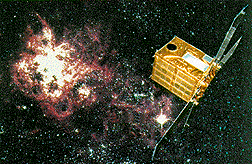 | |
| Names | Astro-C before launch |
|---|---|
| Mission type | X-ray Astronomy |
| Operator | Institute of Space and Astronautical Science University of Tokyo |
| COSPAR ID | 1987-012A |
| SATCAT no. | 17480 |
| Spacecraft properties | |
| Launch mass | 400 kg (880 lb) |
| Start of mission | |
| Launch date | 06:28:00, February 5, 1987 (UTC) (1987-02-05T06:28:00Z) |
| Rocket | M-3S2, mission M-3S2-3 |
| Launch site | Uchinoura Space Center |
| End of mission | |
| Decay date | November 1, 1991 (1991-11-01) |
| Orbital parameters | |
| Reference system | Geocentric |
| Eccentricity | 0.01365 |
| Perigee altitude | 517 km (321 mi) |
| Apogee altitude | 708 km (440 mi) |
| Inclination | 31.1° |
| Period | 97 min |
| Epoch | February 5, 1987 |
ASTRO-C, renamed Ginga (Japanese for 'galaxy'), was an X-ray astronomy satellite launched from the Kagoshima Space Center on 5 February 1987 using M-3SII launch vehicle. The primary instrument for observations was the Large Area Counter (LAC). Ginga was the third Japanese X-ray astronomy mission, following Hakucho and Tenma (also Hinotori satellite - which preceded Ginga - had X-ray sensors, but it can be seen as a heliophysics rather than X-ray astronomy mission). Ginga reentered the Earth's atmosphere on 1 November 1991.
Instruments
- Large Area Proportional Counter (LAC 1.5-37 keV)
- All-Sky Monitor (ASM 1-20 keV)
- Gamma-ray Burst Detector (GBD 1.5-500 keV)
Highlights
- Discovery of transient Black Hole Candidates and study of their spectral evolution.
- Discovery of weak transients in the galactic ridge.
- Detection of cyclotron features in 3 X-ray pulsars: 4U1538-522, V0332+53, and Cep X-4.
- Evidence for emission and absorption Fe feature in Seyfert probing reprocessing by cold matter.
- Discovery of intense 6-7 keV iron line emission from the Galactic Center region.
External links
| Space telescopes | |||||||||||||
|---|---|---|---|---|---|---|---|---|---|---|---|---|---|
| Operating |
| ||||||||||||
| Planned |
| ||||||||||||
| Proposed | |||||||||||||
| Retired |
| ||||||||||||
| Hibernating (Mission completed) | |||||||||||||
| Lost/Failed | |||||||||||||
| Cancelled | |||||||||||||
| Related | |||||||||||||
| Japanese space program | |||||||||||||||||||||
|---|---|---|---|---|---|---|---|---|---|---|---|---|---|---|---|---|---|---|---|---|---|
| |||||||||||||||||||||
| |||||||||||||||||||||
| |||||||||||||||||||||
| |||||||||||||||||||||
| |||||||||||||||||||||
| |||||||||||||||||||||
| |||||||||||||||||||||
| |||||||||||||||||||||
| |||||||||||||||||||||
| |||||||||||||||||||||
| ← 1986Orbital launches in 19871988 → | |
|---|---|
| January | |
| February | |
| March | |
| April | |
| May | |
| June | |
| July | |
| August | |
| September | |
| October | |
| November | |
| December | |
| Launches are separated by dots ( • ), payloads by commas ( , ), multiple names for the same satellite by slashes ( / ). Crewed flights are underlined. Launch failures are marked with the † sign. Payloads deployed from other spacecraft are (enclosed in parentheses). | |
This article about one or more spacecraft of Japan is a stub. You can help Misplaced Pages by expanding it. |
This article about a specific observatory, telescope or astronomical instrument is a stub. You can help Misplaced Pages by expanding it. |